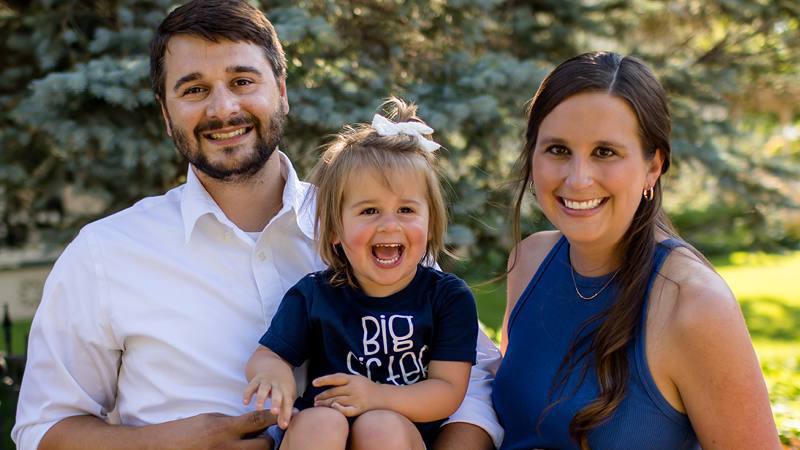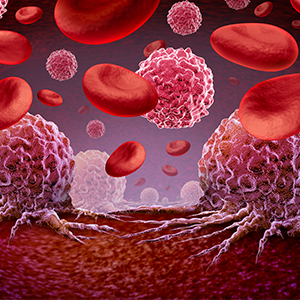
Meckenzie Tinaglia knows her heart. She trusts her intuition, and when her body speaks to her, she pays attention.
So in early April 2021, when Meckenzie found herself in the emergency room for the third day in a row after experiencing terrifying seizure-like events, she listened to her heart when faced with information that the episodes were likely neurologic in nature.
And her heart was telling her something was terribly wrong. Meckenzie’s heart, which had always had a tendency to beat irregularly from time to time, was in crisis and sending signals she couldn’t ignore. Her and her husband Dan’s decision to pursue a second opinion at Mayo Clinic in Rochester, Minnesota, was a choice, they say, that saved her life.
Paying attention to her heart is nothing new for Meckenzie, who lives with Dan and their daughter in North Mankato, Minnesota. She’s been attuned to her cardiac rhythms for a decade, since learning at age 20 that her heart was prone to skip beats. She knows how it feels when her heart misses a beat. She’s seen her heart rhythms mapped often during electrocardiogram (EKG) testing. When she became pregnant, she felt her heart beat irregularly more often, experiencing frequent PVCs, or premature ventricular contraction, for which a local cardiologist prescribed heart medication.
Just about a year after her daughter was born, Meckenzie underwent remote cardiac monitoring using a patch-based device to determine whether she might be a good candidate for an ablation procedure, which would remedy her off-beat heart rhythm. She was, and in late March 2021, Meckenzie underwent the procedure.
Meckenzie healed well and her recovery proceeded as expected. But just a week after the ablation, the problems started. What appeared to be seizures struck Meckenzie while she slept. The culprit for the events, according to her local care team, was neurologic misfiring.

“THEY DIDN’T THINK IT WAS HEART-RELATED AT ALL,” MECKENZIE EXPLAINS. “MY HUSBAND SAID, ‘SHE JUST HAD HEART SURGERY AND I DON’T THINK THIS IS RIGHT.’”
When Meckenzie was discharged from the ER for the third time with an appointment to see a neurologist the following week, the couple took matters into their own hands.
“That is when Dan called Rochester,” Meckenzie says.
Pinpointing the problem through an enhanced monitoring experience
On the phone with Mayo Clinic, Dan was routed to the Department of Cardiovascular Medicine and connected with a cardiac specialist. Dan recounted his wife’s emergency room experiences and asked if Mayo Clinic could offer Meckenzie help. The specialist on the other end of the line informed Dan that Meckenzie could be remotely monitored through Mayo Clinic Cardiac Monitoring using a cellular device called the MoMe monitor.
Remote cardiac monitoring at Mayo Clinic is an extension of inpatient cardiac telemetry and uses Infobionic’s MoMe Kardia monitoring system. The platform was developed by cardiologists for cardiologists worldwide to facilitate monitoring patients who cannot participate in inpatient studies. Built for convenience, the platform empowers providers to make clinical decisions in near real time through access to high quality recording data.
While on the phone with the Mayo Clinic cardiac monitoring specialist, the couple learned the device could be mailed and Meckenzie could start monitoring as soon as it was delivered. But at 2:30 p.m. on a Friday, that meant the device wouldn’t arrive until Monday. Dan asked if they could pick it up that afternoon.
“We literally rushed down to Rochester,” Meckenzie says. “The person who put the monitor on me had to stay a little late and I will never forget, whoever it was who was working, she was able to stay late so I could get it on.”
The couple learned how to use the remote cardiac monitor, turned it on, and returned home to settle in for the night. Meckenzie remembers the monitor being convenient and simple to use.
“It was small and I was able to shower,” says Meckenzie, who at the time was nursing her 1-year-old daughter. “There were no wires, so that was nice.”
That evening, while asleep, the heart-seizing event happened again.
“We went to the hospital and they admitted me this time,” Meckenzie says. “The cardiologist came and said all of my vitals looked good. My husband said to him, ‘She is wearing this MoMe monitor, please go look at the data and see what happened last night while she was seizing.’”
The Tinaglias were assured, based on current EKG readings, that Meckenzie’s heart was fine. When Meckenzie told him that the episodes only ever happened while she was sleeping, she was encouraged to try to take a nap.
“So we were just relaxing in the hospital and it was only about 20 minutes later that the doctor came running up the stairs,” Meckenzie says. “And he said, ‘I just saw the data from MoMe and you’re being airlifted to Rochester.’”
Accurate answers, targeted treatment
The MoMe data showed Meckenzie’s local care team that she’d been experiencing ventricular tachycardia, or V-tach.
V-tach is caused by irregular electrical signals in the lower chambers of the heart that cause the heart to beat faster — usually 100 or more beats per minute. During V-tach, the heart chambers cannot properly fill with blood, which results in not enough blood being pumped to the body. Episodes lasting more than a few seconds may be life-threatening.
“BECAUSE OF THE FULL DISCLOSURE THE MONITORING FACILITATED, WE COULD SEE THIS IMMEDIATELY,” SAYS MAYO CLINIC CARDIAC ELECTROPHYSIOLOGIST PETER NOSEWORTHY, M.D. “THE DOCTORS WERE ABLE TO JUST LOGIN AND SEE WHAT HAD HAPPENED. THE DATA DOESN’T GO TO A THIRD PARTY, IT’S ALL AT THE FINGERTIPS OF THE TREATING PHYSICIAN AND IT EMPOWERS CLINICIANS TO MAKE A DIAGNOSIS IN REAL TIME.”
When Meckenzie arrived at Mayo Clinic, she was stabilized. The following Monday morning she underwent an ablation procedure to remedy the cardiac misfiring.
The clarity and resolution of the data generated during Meckenzie’s monitoring was a tremendous help to her Mayo cardiac team when they did the ablation, says Dr. Noseworthy, the medical director of Mayo Clinic Cardiovascular Services.
“It was a very clear tracing where I could tell exactly what was going on,” Dr. Noseworthy says. “And it was the kind of quality that we were able to actually use it to direct the ablation procedure.”
Following the procedure, which corrected the electrical misfiring, Meckenzie was hospitalized in the intensive care unit for five days. When her tissues had healed, she was implanted with a pacemaker. After spending another three days on the cardiac floor, she was discharged.
“If I had not been wearing the monitor the doctors would not have known I was going into a fatal rhythm and needed immediate medical attention,” Meckenzie says. “It was the data collected on the MoMe that opened their eyes and saw how serious my condition was. It is what got me a helicopter ride to Rochester and part of the reason I am here today. I am so very thankful for modern medicine.”
For patients like Meckenzie, rapid remedies like those enabled through Mayo Clinic’s monitoring program are critical to stop potentially life-threatening heart problems.
With other devices sometimes all you can tell is if the heartrate is fast or slow, and it’s very hard to tell what the underlying arrythmia is,” Dr. Noseworthy says. “So even if a patient has an episode and you’ve actually been able to record it, if the quality isn’t good enough, you’ve spent all this money and spent all of this time and effort and you’re really no further ahead.
“We’ve taken the tactic that we’d rather do less monitoring but higher quality monitoring. And once we get a diagnosis we’re done, because we have a very high-quality, gold standard test.”
Since her experience, Meckenzie has not experienced any more seizure-like episodes. She still listens to her heart, only now the only thing she hears is a slow and steady rhythm.
Learn more about Mayo Clinic Cardiac Monitoring.
Related Articles







